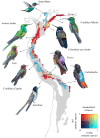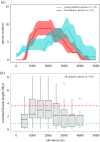Biodiversity cradles and museums segregating within hotspots of endemism
- PMID: 35975440
- PMCID: PMC9382217
- DOI: 10.1098/rspb.2022.1102
Biodiversity cradles and museums segregating within hotspots of endemism
Abstract
The immense concentrations of vertebrate species in tropical mountains remain a prominent but unexplained pattern in biogeography. A long-standing hypothesis suggests that montane biodiversity hotspots result from endemic species aggregating within ecologically stable localities. Here, the persistence of ancient lineages coincides with frequent speciation events, making such areas both 'cradles' (where new species arise) and 'museums' (where old species survive). Although this hypothesis refers to processes operating at the scale of valleys, it remains supported primarily by patterns generated from coarse-scale distribution data. Using high-resolution occurrence and phylogenetic data on Andean hummingbirds, we find that old and young endemic species are not spatially aggregated. The young endemic species tend to have non-overlapping distributions scattered along the Andean treeline, a long and narrow habitat where populations easily become fragmented. By contrast, the old endemic species have more aggregated distributions, but mainly within pockets of cloud forests at lower elevations than the young endemic species. These findings contradict the premise that biogeographical cradles and museums should overlap in valley systems where pockets of stable climate persist through periods of climate change. Instead, Andean biodiversity hotspots may derive from large-scale fluctuating climate complexity in conjunction with local-scale variability in available area and habitat connectivity.
Keywords: Andes; biodiversity; hummingbirds; maintenance; range size; speciation.
Conflict of interest statement
The authors declare no competing interests.
Figures





References
-
- Mittermeier RA, Turner WR, Larsen FW, Brooks TM, Gascon C. 2011. Global biodiversity conservation: the critical role of hotspots. In Biodiversity hotspots: distribution and protection of conservation priority areas (eds Zachos FE, Habel JC), pp. 3-22. Berlin, Germany: Springer.
Publication types
MeSH terms
Associated data
LinkOut - more resources
Full Text Sources
